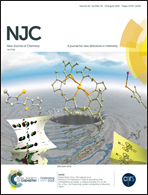Hydrazide-integrated carbazoles: synthesis, computational, anticancer and molecular docking studies†
Abstract
A new class of carbazole-based hydrazides 6a–c, synthesized from carbazole by employing a multistep synthetic strategy, has been described. Detailed insight into their structures (6a–c) has been elucidated by UV-Vis, FT-IR and NMR (1H and 13C) spectroscopic studies. Theoretical investigation of the molecules 6a–c has been accomplished utilizing DFT and TD-DFT techniques with the B3LYP/6-311++G(d,p) method. Theoretical findings such as optimized structural, vibrational, and electronic properties, and proton and carbon chemical shifts of the targets 6a–c are in harmony with their experimental results and/or structurally related reported ones. Cytotoxicity of the target hydrazides 6a–c has been evaluated using human pancreatic cancer cells (AsPC1 and SW1990). The hydrazides 6a–c displayed a significant in vitro cytotoxic effect against both the pancreatic cancer cells AsPC1 (concentration that inhibits 50% cell viability, IC50: 3.42 ± 0.41 μM for 6a) and SW1990 (IC50: 22.42 ± 1.40 μM for 6a). The superior binding energy resulting from the in silico molecular docking approach of the hydrazide 6a indicates its greater affinity towards the receptor (binding energy: −8.63 kcal mol−1 and IC50: 475.05 nM). Thus, the hydrazide 6a could serve as a new lead for the development of anticancer agents.



 Please wait while we load your content...
Please wait while we load your content...